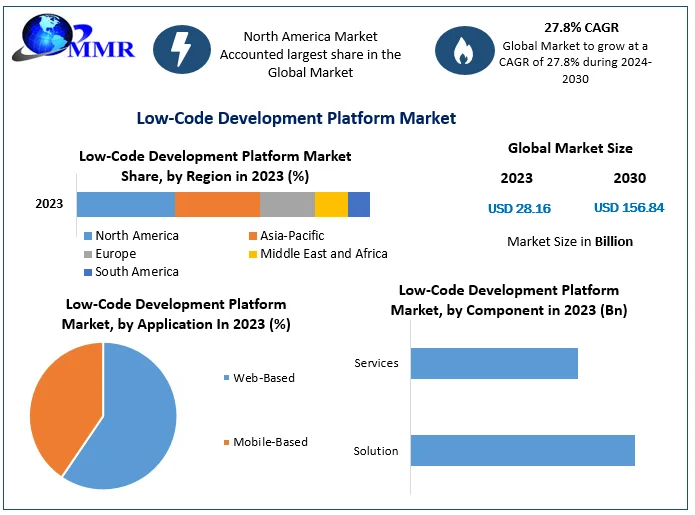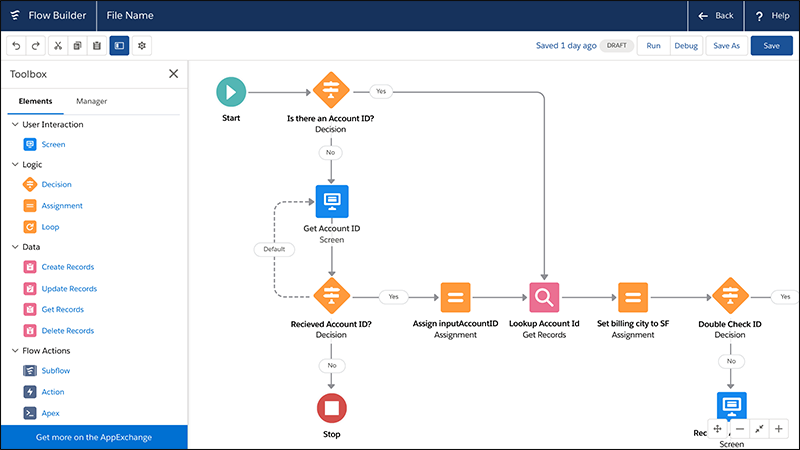Free Suggestions For Picking Low-code platforms for application development
Free Suggestions For Picking Low-code platforms for application development
Blog Article
The Benefits Of Low-Code Development For Non-Developers With Regard To Accessibility
Because of a variety of reasons, low-code application development is easier for non-developers. These are sometimes referred to as "citizens developers."
Drag-and-Drop Builders: Low code platforms include drag-and-drop interfaces that let non-developers create applications without having to write any code. This makes development easier for people with backgrounds in technology.
WYSIWYG Editors WYSIWYG Editors "What You See Is What You Receive" editors assist users in creating workflows and interfaces that appear as if they were the final products which makes them simpler to comprehend.
Simplified Workflow and Logic Design:
Visual Workflow Modelling: Users are able to develop business processes, applications logic and flowcharts through diagrams as well as visual flowcharts. These methods are much more intuitive than the traditional methods of coding.
Pre-built Components for Logic: Low-code platforms often come with already-built logic (e.g. loops or conditional statements) that can easily be adjusted, thus reducing the need for complex programming.
Reusable Components and Templates
Library of pre-built templates Numerous low-code platforms have a library of templates for common application types that allow non-programmers to begin from a solid base and modify as they need to.
Reusable modules and widgets Utilizing modules or widgets that can be reused, the user can simplify the creation process, by cutting down on the need for detailed technical knowledge.
Guided Development Tutorials and Guided Development:
Step-by-Step guide: Platforms provide instructions and help on screen for non-developers building applications.
Interactive Tutorials. Interactive, hands-on tutorials let users gain knowledge by doing.
Integration with tools already in use
Seamless Integration: Low-code platforms have been designed to be easily integrated with the existing business tools and systems (e.g., CRM, ERP) and allow non-programmers to create applications that work with their existing workflows.
APIs Connectors: APIs integrate into apps to facilitate integration. This allows non-programmers, who do not have coding skills, to connect with external services.
Collaboration Features:
Team Collaboration - Features such as real-time collaboration between teams and shared workspaces allow non-developers to work effectively alongside analysts, professionals, analysts, and stakeholders.
Access levels can be set for people who aren't developers in order to ensure that they are able contribute to the development process, but without jeopardizing security.
Automated Debugging and Testing:
Low-code platforms have tools for testing and debugging that are built-in. They automatize the procedure, making it much easier for nondevelopers to ensure their apps run.
Error Highlighting: Whenever problems arise the platform highlights any the errors and suggests solutions, guiding non-developers through troubleshooting techniques.
In general, low-code app development is able to make development more accessible to everyone. This is an important benefit for developers who are not. With its intuitive, visually-focused tools as well as guided experiences low-code applications allow users of business to participate actively in developing and maintaining applications, which bridges the gap between business needs and the technical implementation. View the top Low-code Platform for application development advice for website examples including app modernization, push alerts, cross platform mobile development, sso azure, application modernisation, stored sql procedures, push notifications, develop web application, application modernisation, rapid application design and more.
The Benefits Of Low-Code Development For Governance And Security
Low-code applications offer several benefits for governance and cybersecurity that are essential to ensure that all apps are well-managed, managed and in compliance throughout their lifespan. These are the major benefits.
Unified management console Low-code platforms typically have a central administration console from which administrators manage all applications and ensure consistent governance within the organization.
Role-Based Access Control RBAC : These platforms usually include robust access controls based on roles, which permit administrators to define and enforce policies. This guarantees that only authorized users have the ability to access or modify particular parts of an application.
Compliance and Regulatory Adherence
The advantages of conformity: Many platforms that use low-code are designed to be in line to industry standards. They have frameworks and tools that help to ensure the applications are compliant with these standards.
Audit trails and logs: Comprehensive audit trails and logging can be integrated. This lets companies keep track of changes and access, as well as ensure the compliance of internal policies as well as external regulations.
Additional Security Measures
Data Encryption : Low-code platforms often offer built-in data encryption at rest and during transit. This ensures that data sensitive information is protected.
Security Certificates: A lot of low-code providers have a security certificates (e.g. ISO 27001 and SOC 2) which demonstrate they adhere to the strictest security guidelines. They provide an additional level of assurance to customers.
Automated Security Updates
Regular Updates and Patches Low code platforms typically are able to handle security updates and patches on a regular basis. This means that apps remain protected from the latest threats, without developers having to manually handle.
Security Monitoring - Continuous monitoring for security is often part of the program. This gives real-time information and alerts about security risks that could be a threat.
Data Governance
Data Access Policy: These platforms help companies define and enforce rules for access to data, while making certain that only authorized users can access data and it is used properly.
Data Masking, Anonymization and Anonymization Tools: These programs help protect sensitive personal information and are particularly useful for testing environments.
Consistent Lifecycle Management of Applications:
Pipelines for Development and Deployment Low-code platforms usually offer integrated development and deployment pipelines which include security checks, which ensure security is maintained throughout the application lifecycle.
Version Control: Integrated version control allows for the management of modifications. It also ensures that all modifications to the software are recorded, and if required, reversed. This ensures the security of the program.
User Authentication and Authorization:
Single Sign-On (SSO): Support for single sign-on and other advanced authentication methods makes managing users easier and increases security.
Multi-Factor Authentication A lot of platforms have integrated multi-factor authentication, which adds a layer of extra security when accessing apps.
Compliance Monitoring and Policy Enforcement Compliance Monitoring:
Policy Templates: Low code platforms usually have pre-defined templates for governance and security that allow organizations to quickly apply policies.
Compliance Monitoring Tool: These instruments offer continuous monitoring, reporting and analysis of compliance status. It is simpler to spot potential issues and take proactive actions.
Integration with Existing Security Infrastructure
Seamless Integration: Low-code platforms are designed to integrate seamlessly with existing security infrastructure and tools, including identity management solutions, SIEMs (Security Information and Event Management Solutions), and firewalls.
API Security: API security features to protect data and ensure the integrity of the application are integrated into the API.
Training and the best practices
A lot of platforms provide guidelines and best practices for developing secure applications. They help non-developers meet security standards.
Security Training: Some low-code companies offer security training as well as resources to educate users on how to create and maintain secure applications.
Overall, low-code application developers have a security and governance advantage that allows them to build and manage applications in a safe, secure and secure way. These platforms come with the frameworks, tools, and regulatory compliance necessary to protect sensitive customer data, enforce policy, and ensure compliance with regulatory requirements, while also simplifying the administration and supervision over the application development process. See the most popular my response about Legacy application modernization with Low-code for website info including cross platform app development, develop web application, build a docker container, develop web app, build with docker, mobile development platforms, no code platforms, driver jdbc, lowcode no code, build a docker container and more.
In Terms Of Vendor Support And Community Involvement, Low-Code Development Offers Many Benefits.
Low-code development platforms have significant advantages when it comes to vendor support and the community. These are important to ensure successful implementations, continuous maintenance, and constant development. Here are a few of the advantages.
Comprehensive Technical Support:
Support Teams with Dedicated Support A lot of low-code platforms have dedicated support teams that can assist with technical issues, problem solving and advice. This helps ensure that any issues will be quickly addressed.
Certain vendors provide 24/7 support. This is particularly beneficial to global businesses with different time zones.
Onboarding and Training:
Structured Training Programs: Vendors often provide structured training programs, including tutorials, webinars, and certification courses, to help users get up to speed quickly.
Many companies offer customized onboarding to help customers make use of their platform effectively and tailor it to their requirements.
Regular Updates and enhancements:
Continuous Improvement: Lowcode platform vendors usually regularly release updates that contain new features, performance enhancements and security patches. This helps to ensure that the platform remains up-to date and secure.
Feedback Integration Vendors integrate user feedback into the development process and ensure that the platform is updated in response to the changing requirements.
Comprehensive Documentation:
User documentation in detail Users will find solutions to their issues by reading a detailed and organized manual that covers all aspects of the program starting from its basics to more advanced customisation.
API References: API documentation is detailed and helps developers to integrate the platform with other systems, and to further customize their applications.
Consulting and Professional Services
Expert Consulting : Vendors offer consultancy services, including the design of architectures and complicated implementations. They offer this service to ensure that users are able to benefit from the platform.
Custom Development Services A few vendors provide customized development services to build specific features and integrations which aren't available in the standard.
Community Support
Active User Communities
Forums and Discussion boards Forums and Discussion boards: Many low-code platforms provide active online communities for users to exchange ideas, discuss questions and collaborate.
User Groups and Meetups: Local and virtual user groups and meetups offer opportunities to learn about, network, and share experiences with other users.
Knowledge Sharing and Collaboration
Community-Contributed Resources: Users often share templates, modules, and extensions that they have developed, which can be reused or adapted by others, accelerating development and innovation.
Crowdsourced Solutions: The collective experience the experience, expertise and experiences of a community may prove to be a useful tool in solving problems and coming up with creative solutions.
Learning and Development
Community-led training: Many communities provide webinars, workshops, and training sessions led by experienced users.
Tutorials and online courses: Community members often create and share online courses, tutorials and guides on how-to, improving the education resources available to all users.
Feedback and Influence
Product Feedback Channels: Community forums often offer feedback channels to the manufacturer, which can influence the design of new features and improvements.
Beta Testing Programmes Members of the community who are active may get the chance to take part in beta-testing programs. This allows them to get the first glimpse of new features as well as a chance to help shape the evolution of the platform.
Recognition and Encouragement
Community Recognition Programs: A lot of vendors offer recognition programs for active members of the community. Examples include MVP (Most Valuable Professionals), which recognizes the contributions.
Peer Support: Community members give support to each other, sharing their experience and offering guidance. They build a supportive and supportive environment through sharing their expertise.
Overall, the combination of robust vendor support and an active and active community provides an extensive support ecosystem to develop low-code applications. It makes sure that users have access to the resources, expertise and collaboration opportunities to successfully develop and launch their applications.